Image  Electric vehicles at a Volkswagen factory in Zwickau, Germany, last year. Credit... Ingmar Nolting for The New York Times
Electric vehicles at a Volkswagen factory in Zwickau, Germany, last year. Credit... Ingmar Nolting for The New York Times
President Trump announced in letters posted to social media on Saturday that he would place a 30 percent tariff on goods from the European Union and Mexico, upending months of careful negotiations and disrupting Americas economic relationships with two of its biggest trading partners.
Mr. Trumps tariffs would take effect on Aug. 1, like those on many other trading partners.
But the letters to Mexico, Americas largest source of imports, and the European Union, a trading bloc of 27 nations that collectively make up the worlds third-largest economy, are notable. They marked a significant escalation aimed squarely at two of Americas closest and most pivotal trading partners.
Both economies do a huge amount of trade in goods and services with the United States. And both governments have been in intense negotiations with the United States, right up until Mr. Trumps letters were sent.
Maros Sefcovic, the European Unions trade commissioner, was in regular contact with the U.S. commerce secretary and trade representative. Ursula von der Leyen, the president of the European Commission, spoke to Mr. Trump. And until very recently, officials had hoped they were on the cusp of a deal.
E.U. policymakers had gradually come around to the possibility that the bloc could face 10 percent across-the-board tariffs on all goods sent to the United States, and were hoping to negotiate exceptions for important products. Many of the policymakers were eager to end the economic uncertainty that Mr. Trumps trade announcements had unleashed on German carmakers, Italian wine exporters and Irish pharmaceutical companies alike.
But things changed with Mr. Trumps announcement on Saturday of a flat 30 percent tariff, and his threat to make that rate even higher should the bloc retaliate.
If for any reason you decide to raise your tariffs and retaliate, then, whatever the number you choose to raise them by, will be added onto the 30 percent that we charge, Mr. Trump wrote in the letter, which echoed a form letter he has been sending out to many American trading partners announcing their tariff rate.
Mexican officials had also been in active negotiations. A delegation led by economy minister Marcelo Ebrard arrived in Washington on Friday to discuss an integral agreement with U.S. officials covering border security, migration, trade and water management.
After an intense volley of tariffs from the United States earlier this year related to Washingtons desire to curb the flow of fentanyl across the border, Mexican officials felt they had cultivated a more productive relationship with U.S. officials.
Mr. Trump placed a 25 percent tariff on all Mexican imports earlier this year, sparking an intense dispute. But the administration ultimately lifted most of those tariffs by exempting goods that trade under the United States Mexico Canada Agreement, the North American trade pact, which includes agriculture and other products. According to data from Mexican officials, about 87 percent of exports from Mexico to the United States are not currently subject to tariffs.
Mr. Ebrard said in a statement posted on social media Saturday that U.S. officials had told their Mexican counterparts that as part of the profound change in the United States trade policy, the Trump administration was going to send letters to all world leaders announcing new tariffs.
We mentioned at the negotiating table that it was an unjust move and that we did not agree with it, Mr. Ebrard. He said that Mexican officials would work to ensure that they had an alternative proposal that protects jobs and businesses on both sides of the border before the tariffs take effect Aug. 1.
Mexicos president, Claudia Sheinbaum, said at an event on Saturday that she believed her administration would be able to reach a deal. We know very clearly what we can work out with the government of the United States and what we cant, she said.
In a letter addressed to Mexicos leader and posted to his social media platform, Truth Social, on Saturday, Mr. Trump said, Mexico has been helping me secure the border, BUT, what Mexico has done, is not enough. He blamed Mexico for the American fentanyl crisis, saying cartels had flooded his country with fentanyl and that Mexico still has not stopped the Cartels who are trying to turn all of North America into a Narco-Trafficking Playground.
In recent months, the Trump administration has taken aim at Mexican cartels and those it says work with the groups.
To avoid an earlier threat of tariffs this spring, Ms. Sheinbaum deployed 10,000 troops to the U.S.-Mexico border, building on recent efforts to curb migration by intercepting migrant caravans and busing migrants to places far from the border. Crossings have plummeted to their lowest level in decades.
She also announced a crackdown that has led to record fentanyl seizures, and agreed to extradite dozens of cartel operatives to the United States, breaking with Mexicos previous stance on extraditing the leaders. And Mexicos leaders imposed tariffs and restrictions on many Chinese imports.
Ms. Sheinbaum was broadly praised for her coolheaded approach to Mr. Trump, who called her a marvelous woman after the two spoke about tariffs in February and he offered Mexico an additional month to make gains.
Mr. Trump earlier this week announced that he would aim 35 percent tariffs at Canada another key trading partner, and another nation that had hoped it might be closing in on a negotiated deal with the United States. And he has threatened to slap tariffs ranging from 20 to 50 percent on other nations, including Brazil, Japan and South Korea.
The latest round of levies underscores that Mr. Trump is willing to upend long-held relationships in his quest to rewrite the rules of global commerce. But for major trading partners, the question now is whether they will hit back.
Mexico has never retaliated against the United States, but officials have repeatedly said that they reserve the right to, and have analyzed which U.S. exports they could apply tariffs to.
Ursula von der Leyen, the president of the E.U. executive, said in a statement that Mr. Trumps latest tariffs would disrupt essential trans-Atlantic supply chains, to the detriment of businesses, consumers and patients on both sides of the Atlantic.
She also threatened to hit back, though she did not make a retaliation sound like a foregone conclusion at this point, talking about the proportionate countermeasures if required.
The bloc had already prepared a retaliatory package in response to earlier tariffs, but had paused them to create leeway for negotiation. That retaliation would apply to some 21 billion euros (nearly $25 billion) worth of imports from the United States. The tariffs are scheduled to kick in at 12:01 a.m. Tuesday unless E.U. officials choose to suspend them.
Of course, there are possibilities to react, but we dont want to, Kaja Kallas, the European Unions top diplomat, said in an interview on Friday in Kuala Lumpur, Malaysia. We dont want to retaliate. We dont want this trade war.
In the run-up to Mr. Trumps announcement, officials from the European Union had reiterated that their goal was to reach an agreement in principle, a sort of rough-draft trade plan that could serve as a basis for more detailed negotiations.
If the newly announced tariffs rates remain, however, that means trade war, said Jacob Funk Kirkegaard, a senior fellow at the economic think tank Bruegel in Brussels.
He did not think that Mr. Trumps warning against retaliation would have much effect on the E.U.s appetite to hit back. He said the best Europe can hope for is a situation in which many of Americas global trading partners retaliate, perhaps in a coordinated way, and Mr. Trump is pressured to strike a less extreme stance.
They have consistently said they would defend themselves under the right circumstances, he said. Now those circumstances are here.
Zunaira Saieed, Emiliano Rodr�guez Mega and Annie Correal contributed reporting.
At the opening of a hospital in northern Mexico, President Claudia Sheinbaum said she believed her administration would be able to get an agreement and better conditions for Mexico before the new tariffs announced by President Trump take effect on Aug. 1.
I have always said that in these cases, you need a cool head, she told a crowd of supporters. We know very clearly what we can work out with the government of the United States and what we cant. And theres one thing that is not negotiable, ever: the sovereignty of our country.
Image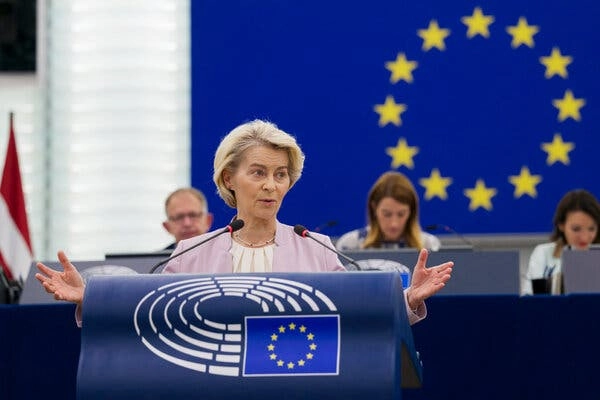 Ursula von der Leyen, the European Commission president, addressing the European Parliament this week. Credit... Jean-Christophe Verhaegen/Agence France-Presse Getty Images
Ursula von der Leyen, the European Commission president, addressing the European Parliament this week. Credit... Jean-Christophe Verhaegen/Agence France-Presse Getty Images President Trumps threat on Saturday to place a 30 percent tariff on goods from the European Union caused outrage among European leaders, with some urging retaliatory tariffs while others said they hoped a deal could still be worked out before the new levies went into effect.
The European Union has been in deep negotiations with Washington in the hope of reaching trade deals that would avert such punishing levies and a wider trade war. But Mr. Trumps threat to impose a 30 percent levy on European and Mexican goods on Aug. 1 upended months of deliberations in one fell swoop, and European leaders are threatening to strike back.
Ursula von der Leyen, president of the European Commission, the E.U.s executive branch, said her administration was ready to keep working toward an agreement before the Aug. 1 deadline. At the same time, we will take all necessary steps to safeguard E.U. interests, including the adoption of proportionate countermeasures if required, she said.
The European Council president, Ant�nio Costa, said on social media that the E.U. remains firm, united and ready to protect our interests.
The European Union had been frantically pushing for an agreement right up until Mr. Trump announced the new tariffs on Saturday morning. Many in Europe had been expecting at least a 10 percent baseline tariff, with some possible exemptions.
President Emmanuel Macron of France suggested the 30 percent rate came as a surprise after weeks of negotiations that he said were made in good faith. He voiced very strong disapproval of the tariffs in a social media post.
France has been one of the loudest voices in Europe calling for retaliatory tariffs against the United States if a deal isnt reached. Mr. Macron reiterated a plea for the European Commission, which is negotiating on behalf of the E.U. countries, to mobilize all the instruments at its disposal.
Others calling for retaliation include Brando Benifei, chair of the European Parliaments delegation for relations with the United States, and Bernd Lange, chairman of the European Parliaments Committee on International Trade.
Mr. Benifei said the E.U.s executive branch should immediately put on the table a series of new credible countermeasures on goods, services, and intellectual property rights that would take effect Aug. 1 without an agreement, and lets no longer postpone those that are due to come into force next week.
Mr. Lange called the tariffs an outrage.
We should no longer wait and see, but use our economic strength to make it clear that these unfair trade practices are unacceptable, he said.
Prime Minister Giorgia Meloni of Italy, one of the few European leaders Trump likes, struck a more cautious tone.
Her office said in a statement that it would make no sense to spark a trade war between the two sides of the Atlantic, and urged negotiators to avoid polarizations that would make reaching an agreement more complex.
Mr. Trump threatened to meet any E.U. tariff retaliation with an equal increase in U.S. tariffs. Experts said that would increase the chances of a wider trade war between the United States and Europe.
Dan OBrien, chief economist at the Institute of International and European Affairs, said on social media that a 30 percent tariff on European goods exported to America would have a significant trade destruction effect.
The new tariffs also prolong the economic uncertainty weighing on various exporters, including German carmakers, Italian wine exporters and Irish pharmaceutical companies.
Hildegard M�ller, who heads V.D.A., the main lobby group for German carmakers, called the latest tariffs regrettable and urged negotiators from the European Union and the United States to find a solution as quickly as possible.
Ms. M�ller said that the 27.5 percent tariffs already in place for cars imported to the United States were hurting German automakers. It remains unclear whether the threatened 30 percent tariffs would apply to imported cars, since Mr. Trumps letters said the latest tariffs would be separate from all sectoral tariffs. If they did apply, European carmakers like Volkswagen would be among the hardest hit. Almost all major carmakers also manufacture vehicles in Mexico.
Advertisement
SKIP ADVERTISEMENT Image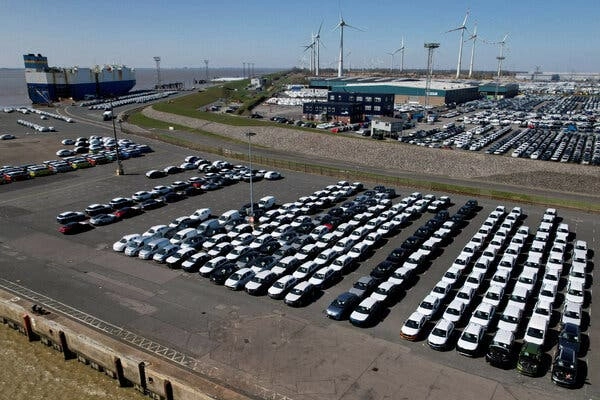 Volkswagen cars in Germany bound for the United States. Credit... Erol Dogrudogan/Reuters
Volkswagen cars in Germany bound for the United States. Credit... Erol Dogrudogan/Reuters The 30 percent tariffs on goods from Mexico and the European Union announced by President Trump on Saturday apparently do not apply to imported cars, some of which are already subject to duties of at least 25 percent.
If so, that would be some relief to carmakers who are already facing weak sales and trying to cope with shifting policies that affect electric vehicles.
President Trump said in letters to Mexico and the European Union that the latest tariffs were separate from all sectoral tariffs, implying that they did not replace the existing tariffs.
A White House official, who spoke on condition of anonymity because he was not authorized to speak publicly, confirmed that the pre-existing carve outs for goods like cars were likely to apply but said the measures were subject to change.
The tariffs already in place exempt goods that comply with terms negotiated with Mexico and Canada in the first Trump administration. That means many cars made in Mexico and Canada, though not all, can avoid paying the tariffs.
Mexico exports more cars to the United States than any other country, so any tariffs on vehicles or parts from there would have a significant effect on prices paid by consumers.
Cars imported from the European Union already pay a 27.5 percent duty as a result of earlier directives by the president. Those duties fall hardest on the German carmakers Mercedes-Benz, BMW and Volkswagen, which make cars in the United States but also import a significant number of them from Europe.
In a statement on Saturday, Toyota said the existing tariffs on imported vehicles, which also apply to Asian countries, were already highly disruptive and cannot be sustained.
Tariffs of this magnitude will lead to significantly higher vehicle prices, further erode affordability and choices for the American consumer, and negatively impact the economy, suppliers and the auto industry, Toyota said.
Ana Swanson contributed reporting.
Image Members of the Mexican armed forces outside a crime scene on the outskirts of Culiacan, Mexico, last month. Credit... Adriana Zehbrauskas for The New York Times
Members of the Mexican armed forces outside a crime scene on the outskirts of Culiacan, Mexico, last month. Credit... Adriana Zehbrauskas for The New York Times As he has in the past, President Trump used the illicit drug trade over the southern border to justify his threat on Saturday to raise tariffs on Mexican goods, even though Mexico has taken steps in recent months to curb drug trafficking.
In a letter addressed to Mexicos leader and posted to his social media platform, Truth Social, on Saturday, Mr. Trump said, Mexico has been helping me secure the border, BUT, what Mexico has done, is not enough. He blamed Mexico for the American fentanyl crisis, saying cartels had flooded his country with fentanyl and that Mexico had failed to stop them.
It was a familiar refrain. From the moment that Mr. Trump took office, he has pressed Mexicos leaders to curb unauthorized migration and illicit drugs. And when Mr. Trump first made his threat in March to raise tariffs on Mexican products to 25 percent, he cited the fentanyl trade as one reason.
On Saturday, Mexican economy minister Marcelo Ebrard posted a statement online saying Mexico was already negotiating. We mentioned at the negotiating table that it was an unjust move and that we did not agree with it, said Mr. Ebrard, who led a delegation recently sent to Washington.
Trying to avert tariffs earlier this year, President Claudia Sheinbaum deployed 10,000 troops to the U.S.-Mexico border, building on the Mexican governments efforts during the Biden administration to curb migration through Mexico. Border crossings have plummeted to their lowest level in decades.
Ms. Sheinbaum also agreed to extradite dozens of cartel operatives to the United States, breaking with Mexicos previous stance on extraditing such leaders, and ordered a crackdown that has led to record fentanyl seizures.
Image Members of the Mexican National Guard at an encampment along the border in Tijuana. Credit... Adriana Zehbrauskas for The New York Times
Members of the Mexican National Guard at an encampment along the border in Tijuana. Credit... Adriana Zehbrauskas for The New York Times Ms. Sheinbaum has been praised for her coolheaded approach to Mr. Trump, who called her a marvelous woman after the two spoke about tariffs in February.
In March, Mr. Trump announced that he would allow products that were traded under the U.S.-Mexico-Canada Agreement, the trade pact he signed in his first term, to be exempted from the 25 percent tariffs he imposed just days before on Mexico and Canada. That has softened the blow for Mexico, where the government says about 87 percent of their goods are covered by the agreement.
At the same time, the Trump administration has taken aim at Mexican cartels and those it says work with the groups.
Last month, the U.S. Treasury Department accused three Mexican financial firms of laundering millions of dollars in connection with fentanyl trafficking by cartels, a claim for which President Sheinbaum said there was simply no proof.
In May, prosecutors in California charged Sinaloa Cartel operatives with terrorism crimes for the first time since a Trump executive order designated that cartel, and the powerful Mexican Jalisco New Generation Cartel, as foreign terrorist organizations. These moves come as the powerful Sinaloa Cartel reels amid an internal crisis and the government crackdown.
After his whipsaw on tariffs in March, Mr. Trump again threatened sanctions and tariffs on Mexico in April, accusing it of failing to provide some 420 billion gallons of water under a 1944 treaty related to water distribution from three rivers. Mexico has been stealing the water from Texas farmers, Mr. Trump said on social media.
Ms. Sheinbaum admitted her country had fallen short of its treaty commitments but blamed a severe, yearslong drought. In late April, leaders announced that Mexico would temporarily channel more water to the United States, a move that appeared to have held off Mr. Trumps threatened tariffs over water.
In his statement on Saturday, Mr. Ebrard, the economy minister, said water management was among the topics that had been raised during negotiations.
Advertisement
SKIP ADVERTISEMENTPresident Trump posted on social media this afternoon that U.S. customs duties have topped $100 billion for the first time during a fiscal year, quoting data released by the Treasury Department on Friday. Its true that tariffs are generating significantly more revenue for the government but its worth remembering who is paying that: importers, who are mostly U.S. businesses.
Image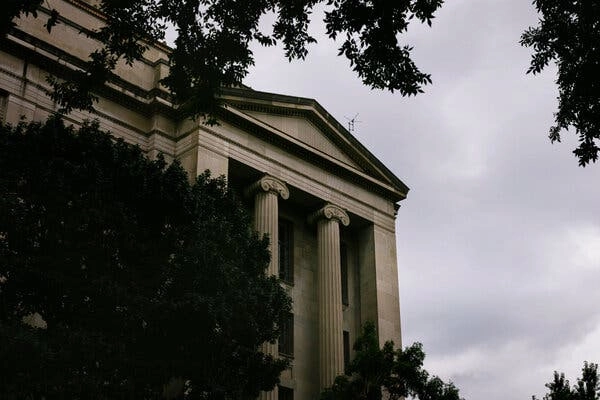 The Department of Justice building in Washington. The purging from government ranks of anyone associated with the federal cases against President Trump has been sporadic. Credit... Jason Andrew for The New York Times
The Department of Justice building in Washington. The purging from government ranks of anyone associated with the federal cases against President Trump has been sporadic. Credit... Jason Andrew for The New York Times The Trump administration fired another batch of nearly 10 Justice Department employees who once worked for the special counsels office that twice indicted President Trump, some in relatively minor roles, according to two people familiar with the matter.
The dismissals on Friday were the latest sign that the administration was reaching deep into the inner workings of the Justice Department to find and expel not just people who had a direct part in investigating and prosecuting Mr. Trump during his four years out of office but also those who had played secondary roles in the office of the special counsel, Jack Smith.
The latest firings, which include at least two federal prosecutors, appeared to once again ignore traditional civil service protections and were said to be based on a broad assertion of presidential authority, according to two people who spoke about the moves on condition of anonymity to avoid discussing a politically sensitive subject.
At least seven others who were fired had served as support staff to Mr. Smiths office, the two people said. They helped manage the office, handling tasks like overseeing financial records, performing paralegal services or conducting information security.
Since the early days of Mr. Trumps second term, the presidents aides have repeatedly sought to fire, punish or demote the people who worked on the cases against him as well on cases stemming from the attack on the Capitol by his supporters on Jan. 6, 2021.
The purging from government ranks of anyone associated with these cases has been sporadic, with fresh batches of firings coming at different intervals and often without much explanation, other than the citing of Article II of the Constitution, which defines the powers of a president.
More dismissals were expected, according to the people familiar with the matter, but Todd Blanche, the deputy attorney general, has been pushing to stop additional firings, according to a person familiar with the situation who spoke on condition of anonymity because they were not authorized to discuss internal deliberations.
Earlier this month, Attorney General Pam Bondi sent letters of dismissal to three prosecutors in the U.S. attorneys office in Washington who had helped to supervise the investigation into Jan. 6, which was the largest criminal inquiry in the Justice Departments history.
A longtime spokeswoman for the U.S. attorneys office, Patricia Hartman, also was recently fired.
Those moves came nearly five months after several prosecutors who had worked on prominent Jan. 6-related cases against the far-right extremist groups the Proud Boys and the Oath Keepers were demoted to handling low-level criminal cases.
In January, more than a dozen junior prosecutors who had worked on Jan. 6 cases were fired outright.
Even as much of this was happening, the Justice Department under Mr. Trump has hired people who have served as vocal advocates for the rioters charged in connection with the Capitol attack.
Ed Martin, a prominent supporter of Jan. 6 defendants, was Mr. Trumps initial pick to run the U.S. attorneys office in Washington. When it appeared that he would not survive Senate confirmation, largely because of his close connections to the rioters, Mr. Martin was named to be the Justice Departments pardon attorney and tapped to lead the so-called Weaponization Working Group, a task force established to seek retribution against Mr. Trumps political enemies.
Recently, Mr. Martin hired as one of his advisers on the weaponization task force a former F.B.I. agent who had been charged with encouraging the mob at the Capitol to kill police officers on Jan. 6. Mr. Trump granted clemency to all of the nearly 1,600 people charged in connection with the events that day.
Glenn Thrush contributed reporting.
A White House official who wasnt authorized to speak publicly said that Trumps new tariffs on Mexico would replace, rather than add to, the previous levies that Trump imposed on the country, and that goods that trade under the U.S.-Mexico-Canada Agreement would likely be exempt. If so, that would mean these tariffs would have a more limited effect on Mexico, since the bulk of Mexican exports are covered by the trade agreement 87 percent, according to the Mexican government. Essentially, Trumps threat would mean that, for that roughly 13 percent of exports that are not covered by the trade agreement, U.S. tariffs would increase from 25 percent to 30 percent as of Aug. 1.
Advertisement
SKIP ADVERTISEMENTEuropean leaders are sounding tougher notes about President Trumps 30 percent tariff threat as the day wears on. European Council President Ant�nio Costa said on X that the E.U. remains firm, united and ready to protect our interests. Prime Minister Pedro S�nchez of Spain, who angered Trump by refusing to commit to a NATO pledge to increase military spending to 5 percent over a decade, said unjustified tariffs would destroy economic openness and trade.
The chairman of the Committee on International Trade in the European Parliament called President Trumps letter threatening 30 percent tariffs an outrage and urged the European Union to respond immediately with countermeasures. We should no longer wait and see, but use our economic strength to make it clear that these unfair trade practices are unacceptable, Bernd Lange said.
The head of Germanys main lobby group for the automobile industry, V.D.A., urged negotiators from the European Union and the United States to work to find a solution as quickly as possible. She warned that the tariffs of 27.5 percent already in place for car imports to the United States were hurting German automakers.The costs for our companies are already in the billions, and the sum is growing every day, Hildegard Muller, president of the V.D.A. said.
President Emmanual Macron of France declared in a social media post his very strong disapproval of Trumps plan to levy 30 percent tariffs on E.U. exports. France has been one of the loudest voices in Europe calling for retaliatory tariffs against the United States if a deal isnt reached, and Macron reiterated a plea for Brussels, which negotiating on behalf of all 27 E.U. countries, to mobilize all the instruments at its disposal. Many in Europe had been expecting Trump to keep a current 10 percent across-the-board tariff on Europe, and Macron suggested the 30 percent rate had come as a surprise after weeks of negotiations made in good faith.
Advertisement
SKIP ADVERTISEMENT Image Rosie ODonnell in Dublin. Credit... Ellius Grace for The New York Times
Rosie ODonnell in Dublin. Credit... Ellius Grace for The New York Times President Trump said he was weighing using the power of the government against one of his longtime entertainment world nemeses, the comedian and actress Rosie ODonnell, threatening to revoke her citizenship.
Shortly before 10 a.m. on Saturday, Mr. Trump said on Truth Social, Because of the fact that Rosie ODonnell is not in the best interests of our Great Country, I am giving serious consideration to taking away her Citizenship.
The president called Ms. ODonnell a threat to humanity and said she should stay in Ireland, where she moved to in January after Mr. Trump won a second term.
Mr. Trumps headline-grabbing provocation about Ms. ODonnell comes at a moment in which his administration is contending with criticism on many fronts: His top law enforcement officials are bitterly feuding over the Jeffrey Epstein saga; there remain unanswered questions about the decision to halt munitions to Ukraine and who authorized it; the homeland security chief is facing intense scrutiny over FEMAs response in Texas; and so on.
Ms. ODonnell snapped back at Mr. Trump with her own barrage of insults on Instagram.
The president of the USA has always hated the fact that I see him for who he is a criminal con man sexual abusing liar out to harm our nation to serve himself, she said. This is why I moved to Ireland.
She further taunted the president in a subsequent post showing a photo of Mr. Trump with Jeffrey Epstein, taken in 1997 in Palm Beach, Fla.
You want to revoke my citizenship? Go ahead and try, King Joffrey with a tangerine spray tan, she said, referring to the sadistic child-king in Game of Thrones.
Experts said the president does not have the power to take away the citizenship of a U.S.-born citizen.
Julia Gelatt, associate director of the immigration program at the Migration Policy Institute, said: U.S. citizens can relinquish their citizenship voluntarily, and federal courts can strip naturalized citizens of their citizenship if there is proven fraud or misrepresentation or other major cause. But U.S.-born citizens cannot have their citizenship taken away.
Amanda Frost, an expert on citizenship law at the University of Virginia School of Law, cited Supreme Court precedent.
In 1967, the U.S. Supreme Court declared in Afroyim v. Rusk that the Citizenship Clause of the Fourteenth Amendment bars the government from stripping citizenship, stating: In our country the people are sovereign and the government cannot sever its relationship to the people by taking away their citizenship, she said in an email.
Mr. Trumps feud with Ms. ODonnell dates back to 2006, when she mocked the president on The View for defending a Miss USA contestant roiled in a controversy. She questioned his own moral compass and role as a businessman. Mr. Trump, who at the time was best known for his show, The Apprentice, threatened to sue The View over her comments.
Soon after, Mr. Trump began hurling insults at Ms. ODonnell, calling her fat and wacko. In a 2015 G.O.P. debate on Fox News, one of the moderators said, Youve called women you dont like fat pigs, dogs, slobs and disgusting animals. Mr. Trump interjected: Only Rosie ODonnell.
Mr. Trumps threat to revoke Ms. ODonnells citizenship is the latest in a series of statements he has made about political adversaries and celebrities who have criticized him.
After the billionaire Elon Musk and Mr. Trump fought publicly over the presidents sprawling domestic policy bill, the president suggested he might be interested in deporting Mr. Musk.
When asked by a reporter if he would deport Mr. Musk, a naturalized U.S. citizen who was born in South Africa, Mr. Trump responded, I dont know. Well have to take a look.
Mr. Trump has repeated baseless claims that Zohran Mamdani, the Democratic nominee for mayor of New York City, is an illegal immigrant. Mr. Trump has threatened to arrest him if he interfered with the federal crackdown on undocumented immigrants. Hes also called for major investigations into celebrities like Bruce Springsteen and Beyonc�, calling their endorsements of Kamala Harris in last years presidential election corrupt and unlawful.
Image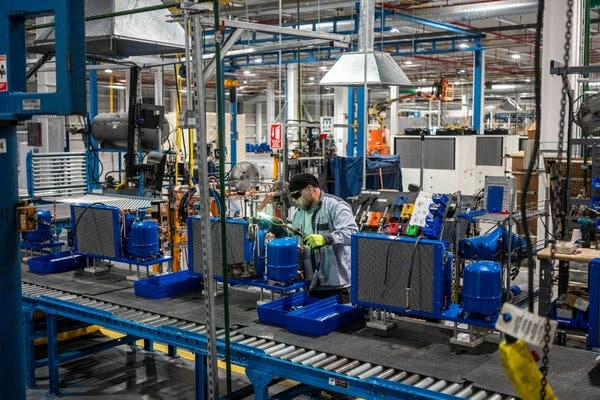 Workers assemble products at the Danfoss factory in Apodaca, Mexico. Credit... Cesar Rodriguez for The New York Times
Workers assemble products at the Danfoss factory in Apodaca, Mexico. Credit... Cesar Rodriguez for The New York Times Mexican officials have been negotiating for months in hopes of reaching a trade deal with Washington that would not devastate the countrys export-driven economy, but President Trump upended those talks on Saturday when he threatened to impose a 30 percent tariff on Mexican imports, potentially igniting a trade war with one of Americas largest trading partners.
In a letter to Mexicos president, Claudia Sheinbaum, Mr. Trump said that Mexico was not doing enough to curb the flow of fentanyl into the United States and cited that as the reason for the tariffs. Mr. Trump added that Mexican companies were welcome to manufacture their products in the United States to avoid the tariffs.
The tariffs are set to take effect on Aug. 1 and are similar to the levies that the United States is imposing on imports from Canada and the European Union, which Mr. Trump said separately on Saturday would also face 30 percent duties. The tariffs come despite the fact that Mr. Trump brokered a trade deal with Mexico and Canada during his first term that was intended to stabilize economic relations between the United States and its neighbors.
Mr. Trump also warned Mexico not to retaliate with higher tariffs of its own. He said that whatever additional tariffs Mexico might impose would be added to the 30 percent rate he announced.
The president added that drugs were not the only issue of concern to the United States and pointed to other Mexican policies that contributed to unsustainable trade deficits.
The Trade Deficit is a major threat to our Economy and, indeed, our National Security! Mr. Trump wrote in the letter.
Mr. Trump has been going back and forth on tariffs on Mexico for months.
In March he announced plans to impose a 25 percent tariff on Mexican imports. Mexican officials warned that the import tax would cause food shortages in the United States and called it a strategic mistake.
Later, he exempted goods that trade under the United States-Mexico-Canada Agreement, the trade pact Trump negotiated in his first term. Currently, because of that U.S.M.C.A. exemption, about 87 percent of Mexican exports to the U.S. trade tariff free, according to data from the Mexican government.
A White House official who wasnt authorized to speak publicly said Saturday that Mr. Trumps new tariffs on Mexico would replace, rather than add to, the previous levies that the president imposed on the country, and that goods that trade under the United States-Mexico-Canada Agreement will likely be exempt.
The Mexican economy minister, Marcelo Ebrard, who is leading a Mexican delegation in Washington to discuss issues on border security, migration and trade, said U.S. officials told their Mexican counterparts that, as part of the profound change in the United States trade policy, the Trump administration was going to send letters to all world leaders announcing new tariffs.
We mentioned at the negotiating table that it was an unjust move and that we did not agree with it, Mr. Ebrard said in a statement posted on social media on Saturday.
Mexican officials said that they would work to ensure that, before the new tariffs take effect on Aug. 1, we have an alternative that allows us to protect businesses and jobs on both sides of the border.
Emiliano Rodr�guez Mega and Ana Swanson contributed reporting.
Advertisement
SKIP ADVERTISEMENTThe main lobby group representing Germanys industrial companies urged the German government and European leaders to find solutions very quickly through discussions with U.S. representatives before the new 30 percent tariffs announced on Saturday take effect on Aug. 1. A trade conflict between two economic areas as closely intertwined as the E.U. and the U.S.A. damages economic recovery, innovative strength and, ultimately, also trust in international cooperation, said Wolfgang Niedermark, a member of the board of the Federation of German Industries, or B.D.I.
A 30 percent tariff on European goods exported to America would have a significant trade destruction effect, Dan OBrien, chief economist at the Institute of International and European affairs, said in a post on X. He added that the chances of a wider trade war between the United States and Europe had risen after President Trumps threat to meet any E.U. tariff retaliation with an equal increase in the U.S. tariffs.
Brando Benifei, the chair of the delegation for relations with the United States at the European Parliament, called on the E.U.s executive branch to retaliate against President Trumps 30 percent tariffs. Lets immediately put on the table a series of new credible countermeasures on goods, services and intellectual property rights that would take effect Aug. 1 without an agreement, and lets no longer postpone those that are due to come into force next week, Benifei said in a written message.
Prime Minister Giorgia Meloni of Italy is one of the few European leaders that President Trump likes. She has visited him at the White House and has attempted to play a balancing role. After Trump said he would impose a 30 percent tariff on European goods on Saturday, her office issued a statement cautioning that it would make no sense to spark a trade war between the two sides of the Atlantic, and urging negotiators to avoid polarizations that would make reaching an agreement more complex. Europes own negotiations will intensify in the coming days, the statement said.
Advertisement
SKIP ADVERTISEMENTThe Mexican economy minister, Marcelo Ebrard, who is leading a delegation to Washington to discuss a range of issues, said U.S. officials told their Mexican counterparts that as part of the profound change in the United States trade policy, the Trump administration was going to send letters to all world leaders announcing new tariffs. We mentioned at the negotiating table that it was an unfair move and that we did not agree with it, Ebrard said in a statement on social media.
Mexican officials agreed that they would work to ensure that, before Aug. 1 when the new tariffs take effect, we have an alternative that allows us to protect businesses and jobs on both sides of the border, Ebrard said. Mexico, he added, is already negotiating.
Karin Karlsbro, a European Parliament member who sits on its international trade committee, called on the European Union to remain united after Trumps threat to impose 30 percent tariffs on the bloc. We will not give in to blackmail. Tariffs are a tax on consumers & businesses, she wrote on X. Europe must not back down and make use of our toolbox if the US refuses a fair deal.
The European Union was informed of President Trumps latest tariffs in advance, learning of them Friday, said Paula Pinho, a spokeswoman for the blocs executive arm.
In reaction to President Trumps 30 percent tariffs on the European Union, Ursula von der Leyen, the president of the E.U.'s executive branch, said in a statement that such tariffs would disrupt essential transatlantic supply chains, to the detriment of businesses, consumers and patients on both sides of the Atlantic. She also threatened to hit back, though she did not make a retaliation sound imminent, talking about the adoption of proportionate countermeasures, if required.
Advertisement
SKIP ADVERTISEMENTTrump released letters imposing new 30 percent tariffs on imports from Mexico and the European Union. The tariffs will take effect on Aug. 1. They will be on top of sectoral levies that are already being imposed on imports of goods such as steel. Trump wrote that the trade deficit is a major threat to our Economy and, indeed, our National Security!
The tariffs on Mexico are similar to what President Trump imposed on Canada and come despite the fact that the three countries already have a trade pact that was sealed during the first Trump administration. Mexico and Canada are among the largest U.S. trading partners.
Image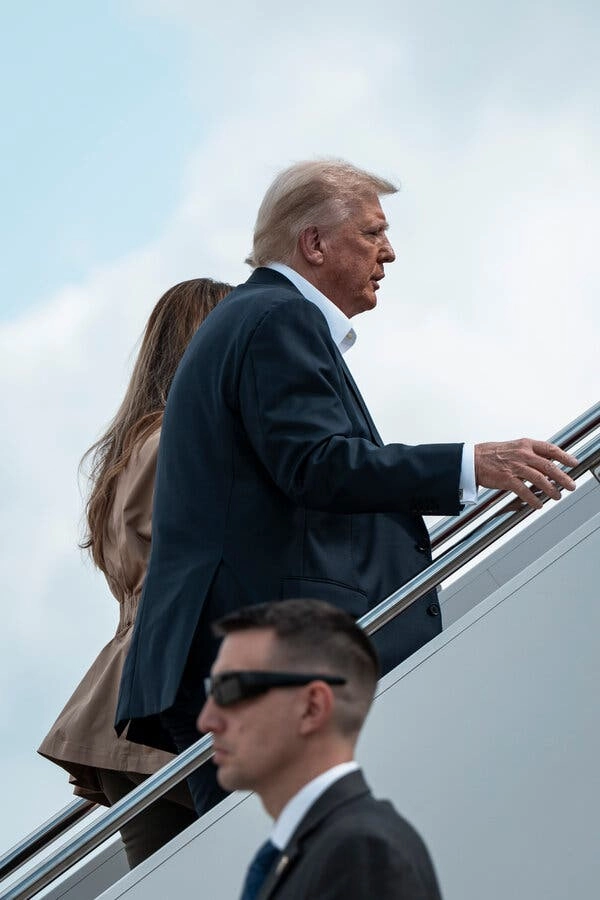 Even when President Trump strikes trade deals, double-digit tariffs are often left in place, with more levies on foreign products on the way. Credit... Haiyun Jiang/The New York Times
Even when President Trump strikes trade deals, double-digit tariffs are often left in place, with more levies on foreign products on the way. Credit... Haiyun Jiang/The New York Times Even after President Trump announced sweeping global tariffs in April, some investors and supporters comforted themselves by arguing that the presidents goal was still to open global markets, not close them off.
The belief, promoted by Mr. Trump himself, was that he was using his tariffs as a lever to crack open commercial opportunities and the administration would soon deliver dozens of deals that would increase U.S. exports and help American businesses flourish abroad.
Three months later, that optimism is being replaced by doubts that Mr. Trumps goal was ever to strike the kind of trade deals that would open up markets.
Instead, the president is making new announcements daily about bruising tariffs that will come into effect against dozens of trading partners in just a few weeks. On Saturday, Mr. Trump announced on social media that he would place a 30 percent tariff on goods from the European Union and Mexico, starting on Aug. 1. That followed similar threats this week warning Canada, Japan, South Korea, Brazil, and numerous other nations large and small, of forthcoming tariffs.
Administration officials continue to describe the presidents tariff threats as a gambit aimed at getting more concessions from foreign countries in trade negotiations. But, according to Mr. Trumps timeline, the window to strike deals and avoid punishing tariffs is rapidly diminishing. So far, the administration has only announced two preliminary deals, with Britain and Vietnam, and the status of the Vietnam deal is now in question.
While handshake agreements with India, Taiwan and other governments could soon be pending, they are likely to be limited pacts that leave much to be negotiated. And even when deals have been announced, Mr. Trump has left double-digit tariffs in place, and promised that more levies on foreign products are on the way.
With less than a month before the Aug. 1 tariffs are supposed to kick in, the Trump administration may have the capacity to deal with only a fraction of the other countries the president is threatening with stiff levies. Some governments that have sought out meetings with U.S. officials have not been able to schedule them.
When Mr. Trump paused his global tariffs for 90 days in April, he said the delay would give his administration time to reach trade deals with countries across the world. Mr. Trump boasted in the intervening months about how countries were lining up to talk to the United States and at one point claimed he had reached 200 deals.
But in the last several weeks, Mr. Trump has seemed unbothered by not having more deals to announce. Instead, he has extolled the volume of tariffs he is heaping on Americas trading partners, claiming that they are more than justified and are bringing in huge sums of money to the United States.
Everybody has to pay and the incentive is that they have the right to deal in the United States. If they dont want to, they dont have to pay, he said during a cabinet meeting on Tuesday.
He also acknowledged that his government doesnt have the capacity to do trade deals with every nation.
We have made some deals, he said. We can make a lot more deals. Its just too time consuming. It just makes it more complicated. And we can do things over the years, too.
We got 200 countries. We cant meet with 200 countries, he added.
The White House did not respond to a request for comment. A White House official said that deals and tariffs werent mutually exclusive for the Trump administration. For many deals, including the one announced with Britain, higher tariffs have been part of the overall package, along with concessions to open up the foreign market, he said.
Many of Mr. Trumps supporters are happy that he is leaving high tariffs in place, saying they are needed to ensure that the valuable U.S. market is preserved for American companies.
Several of the major trading partners that Mr. Trump has threatened with tariffs this week had already previously negotiated trade deals with the United States, or with Mr. Trump himself. That includes Canada and Mexico, which signed a trade deal with the United States during Mr. Trumps first term, as well as South Korea and Japan.
Many other countries that have received tariff letters have been in active negotiations with the United States. Mexican officials were in Washington on Friday to discuss a pact that would address trade, migration and border security. But that has appeared to be little deterrent to Mr. Trump.
The renewed threats and the prospect of the trade wars they could bring about raise questions about whether any of the presidents supporters will break with him on his aggressive strategy.
Republicans who have long supported free trade, or who come from agricultural states that depend on foreign markets, have long tried to argue that, in the hands of a consummate dealmaker, Mr. Trumps tariffs could be a tool for more trade, not less. But some have been dismayed by the prospect of stiff tariffs against allies like Canada, Mexico and Europe, all major markets for U.S. farmers and exporters.
During a hearing in April, shortly after Mr. Trump had announced his global tariffs, Republican senators argued that trade wars would harm U.S. exporters and pressed Jamieson Greer, Mr. Trumps top trade negotiator, not to keep tariffs in place in the long run.
Steve Daines, a Republican senator from Montana, said there was hope that these tariffs are a means and not solely an end.
Senator Chuck Grassley, a Republican of Iowa, said he had taken a wait and see approach to tariffs because he believed Mr. Trump was using them as a tool to get fairer trade. If thats not the case, level with me, he told Mr. Greer.
Stock market investors also appear to have been betting that Mr. Trump will not actually follow through on many of his tariffs, seeing them more as a negotiating tool than a concrete economic threat.
But Mr. Trumps Aug. 1 deadline is closing in and he has insisted he will not delay the global tariffs any longer.
Ernie Tedeschi, the director of economics at the Budget Lab at Yale University, said that the countrys average effective tariff rate on imported products had gone from just 2.5 percent at the beginning of the year to 18.7 percent, including the tariff letters the president issued last week. Thats the highest average U.S. tariff rate since 1933, on par with the Smoot-Hawley tariff peaks that worsened the Great Depression.
To me thats pretty conclusive evidence that hes a protectionist, Mr. Tedeschi said. I think this is an administration that just likes tariffs as a policy.
Wendy Cutler, the vice president at the Asia Society Policy Institute, said that Mr. Trumps policies included an element of opening markets, as well as protectionism. U.S. negotiators are working hard to push other countries to open up their markets, she said. Thats all about increased access for U.S. exporters. But, lets be honest, at the same time, were putting up high tariffs.
She also argued that, even if the administration doesnt strike many deals, it could cover a significant portion of U.S. trade through a few deals with major trading partners. If indeed deals are announced with India and the E.U. over the next three weeks, that would carry a lot of weight, she said.
Mr. Trumps tariffs have clearly created leverage with other trading partners, and dozens of foreign countries have appealed to the White House to try to strike better trade terms. But business leaders have stressed that, so far, the presidents tactics are making it more difficult, rather than easier, for them to do business abroad.
Jake Colvin, the president of the National Foreign Trade Council, which lobbies on behalf of international business, said that it was shocking how far the center of gravity has moved on the tariff conversation.
Back when the president floated the idea of a universal baseline tariff a year ago as a candidate, everyone was aghast at how dramatic that would be, he said. And now theres almost relief by companies and businesses that a 10 percent baseline tariff might be the best they can get.
Image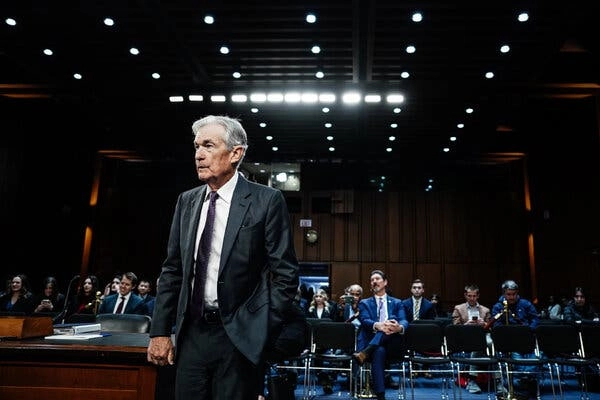 Jerome H. Powell on Capitol Hill in February. On Friday, the Federal Reserves website posted a Frequently Asked Questions section about renovations to its headquarters. Credit... Haiyun Jiang for The New York Times
Jerome H. Powell on Capitol Hill in February. On Friday, the Federal Reserves website posted a Frequently Asked Questions section about renovations to its headquarters. Credit... Haiyun Jiang for The New York Times The Federal Reserve took steps on Friday to defend itself against accusations by President Trump and his allies that Jerome H. Powell, the Fed chair, mismanaged renovations at the central banks headquarters and then lied to Congress about those plans.
The new line of attack, after Mr. Trump aimed a barrage at the Feds reluctance to lower borrowing costs, has raised alarm that the White House is trying to lay the groundwork to fire Mr. Powell for cause.
In an update to its website late Friday, the central bank laid out details intended to support Mr. Powells statements to lawmakers regarding the project, which kicked off in 2021 and is estimated to be $700 million over budget at around $2.5 billion.
The extent of the renovations and their swelling cost have spawned intense criticism from both the White House and a number of leading Republicans, who have taken issue with luxury features in an initial plan, including rooftop garden terraces and marble finishings.
Mr. Trump said on Friday that he was not planning to fire Mr. Powell, despite saying the Fed chair was doing a terrible job. But legal experts warned that the latest front in the White Houses attacks on the central bank could potentially be pursued as an avenue to remove Mr. Powell as chair before his term expires in May.
We cant ignore context when we are looking at these accusations, said Kathryn Judge, a financial regulation expert at Columbia Law School. What theyre trying to do is build up a public case and to discredit him.
Russell Vought, director of the Office of Management and Budget and one of the most vocal critics of Mr. Powell regarding the renovations, has pressed for an investigation into whether the chair was deceptive about the plans when he testified in Congress last month.
This is about the largess and the fact that he has systemically mismanaged the Fed, Mr. Vought said in an interview with CNBC on Friday.
A day earlier, he wrote a letter to Mr. Powell in which he condemned the project and questioned whether it was in compliance with rules around such renovations. Instead of attempting to right the Feds fiscal ship, you have plowed ahead with an ostentatious overhaul of your Washington, D.C., headquarters, he wrote.
In a post on its website on Friday, the Fed addressed many of the questions in Mr. Voughts letter, which specifically asked about the latest plans that Mr. Powell had relayed to lawmakers.
Theres no V.I.P. dining room, theres no new marble, the chair said at the time. There are no special elevators theres just, there are old elevators that have been there there are no new water features, theres no beehives and theres no roof terrace gardens.
Mr. Powell added that the projects plans had continued to evolve and that some features that had been initially incorporated were scrapped.
The Frequently Asked Questions post on Friday reaffirmed those responses and said: The Federal Reserve takes seriously the responsibility to be a good steward of public resources. The project will reduce costs over time by allowing the Board to consolidate most of its operations.
A person familiar with the matter at the Fed said that Mr. Powell had been honest during his testimony and that no one involved in the project had informed the central bank that any scaling back of the plans needed to be resubmitted to the National Capital Planning Commission, which is responsible for reviewing the Feds proposal.
This week, Mr. Trump installed three White House advisers to that commission, including a deputy chief of staff, James Blair, and the staff secretary, Will Scharf.
The latest attempt to undermine the Fed chair comes as the Supreme Court has re-established that the president is limited in his ability to remove an official at the central bank without cause. That typically has meant serious misconduct and other violations.
Scott Alvarez, a former general counsel at the Fed board, said proving that is really, really hard to do because it is so ambiguous.
The case here is so light that I dont think its credible, he said. I think this is just about building pressure on the chair to make him feel uncomfortable and make him want to leave.
Graham Steele, a longtime financial regulation lawyer and former Treasury Department official, likened it to a game of chicken" in which the White House was pressuring the Fed so that it either lowered interest rates or was thrust in the middle of this giant political storm.
Advertisement
SKIP ADVERTISEMENT Image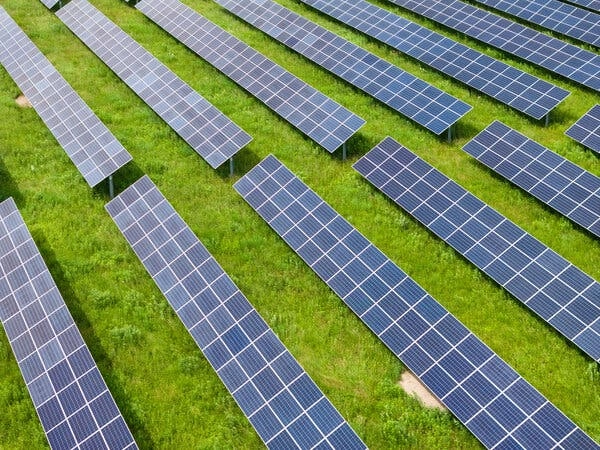 The changes would reduce funding for solar power projects to about $42 million from $318 million. Credit... Tim Gruber for The New York Times
The changes would reduce funding for solar power projects to about $42 million from $318 million. Credit... Tim Gruber for The New York Times The Energy Department plans to eliminate hundreds of millions of dollars in funding for major renewable and efficiency projects this year, the latest move by the Trump administration to undo efforts to shift the nation away from fossil fuels.
The cuts, which would take money away from projects budgeted for the fiscal year that ends Sept. 30, focus on solar and wind projects, as well as state and local assistance for low-income families, according to an Energy Department document reviewed by The New York Times and Democratic lawmakers in Washington. Critics argue that the moves are illegal because Congress had previously approved the funding for specific projects.
In a joint statement about the funding changes, ranking Democrats on the Senate and House energy subcommittees called it a reckless decision and demanded the agency immediately reverse its action. They argued that the moves would harm efforts to strengthen U.S. energy independence and drive up costs for all consumers.
This outrageous, unlawful decision by the Trump administration is a direct attack on our energy independence and American families ability to afford their monthly energy bill, wrote Senator Patty Murray, Democrat from Washington, and Representative Marcy Kaptur, an Ohio Democrat. This isnt a bureaucratic misstep its a deliberate, partisan effort to sabotage bipartisan law and redirect funding.
In response to inquiries about the cuts, an Energy Department spokeswoman said in a statement that the agency is working to instill a culture of transparence, performance and common sense.
The Department of Energy is working to advance its critical mission of unleashing affordable, reliable and secure energy for all Americans while increasing efficiency and promoting better stewardship of taxpayer dollars, the spokeswoman said. The new funding levels help ensure that the Department accomplishes its critical mission for the American people.
The changes would cut up to 90 percent of the funding from the two fastest growing renewable energy technologies, according to the document, which details planned budget appropriations. Cuts include reducing money for wind power projects to about $30 million from $137 million, and solar power to about $42 million from $318 million.
In addition, the plan cuts nearly all of the money from state and local government community energy programs, which help reduce heating and cooling costs and assist with services like home energy audits and increasing insulation in homes.
The Trump administration has targeted solar and wind power and energy efficiency programs for funding cuts in its push to reshape the nations energy future. The administration has emphasized broader use of fossil fuels, including natural gas for electricity and oil for transportation.
That strategy also calls for rolling back emissions standards to encourage more use of oil and gas a major reversal of the Biden administrations policies to reduce carbon emissions and encourage the use of clean energy technologies such as solar and wind power, and electric vehicles. Earlier this year, the Energy Department said that it would roll back energy and water conservation standards for a long list of electric and gas appliances. The Environmental Protection Agency is shutting down the popular Energy Star program.
The shift away from the clean energy and energy efficiency initiatives could lead to a dramatic increase in costs for all consumers.
Solar and onshore wind power are among the least expensive sources of electricity. And energy efficient appliances have helped keep residential electric bills a bit in check.
But extreme weather events, driven by climate change, are pushing up energy costs as utility companies invest in long-overdue upgrades to the aging power system. And electricity demand has grown in recent years because of energy-hungry data centers that technology companies are using to support the development of artificial intelligence.
That growth in demand and the need for increased power supply and storage has created challenges in the reliability of the electric grid.
Solar and storage is the fastest and in most cases the cheapest way to meet the skyrocketing demand from A.I., data centers, and American innovation, Abigail Ross Hopper, chief executive of the Solar Energy Industries Association, said in response to the planned cuts. In the race to ensure global A.I. leadership and energy independence at home, we should be focused on getting every electron that we can generate on the grid.
Solar and wind power have become more readily available to meet some of those needs, along with battery storage. But a lack of supply of massive turbines used to generate electricity from natural gas has slowed the construction of new fossil fuel generators, and hopes for new nuclear power plants remain far into the future.
Some of the money designated for solar and wind power in the budget has been redistributed to other clean energy resources, such as hydroelectric power and geothermal energy, but those also are expensive to build and can take years to bring online.
That has left critics of the cuts questioning the strategy the Trump administration is using at a time of grid constraints and rising costs.
The nationwide average cost for the typical 1,000 kilowatt-hours of use by a residential consumer rose almost 4 percent to $175 a month in April compared to the same time a year ago, according to data from the Energy Information Administration.
That has added an even greater burden on those who can least afford the higher costs, who now face cuts to programs like the Low-Income Home Energy Assistance Program, and the community energy assistance dollars.
Both of these programs are incredibly important for affordability, said Mark Toney, executive director of The Utility Reform Network, a California organization that helps low-income energy consumers. Zeroing out the state community energy programs will directly harm low-income families.
Image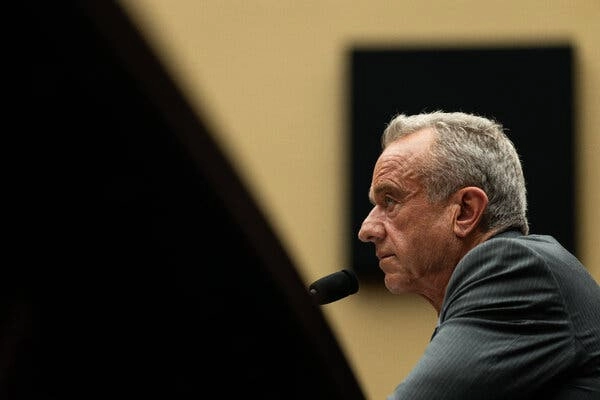 Robert F. Kennedy Jr., the health secretary, has the authority to declare the spread of measles a public health emergency, an action that would mobilize federal funding and expedite the availability of tests and treatments. Credit... Tierney L. Cross/The New York Times
Robert F. Kennedy Jr., the health secretary, has the authority to declare the spread of measles a public health emergency, an action that would mobilize federal funding and expedite the availability of tests and treatments. Credit... Tierney L. Cross/The New York Times Days after measles cases in the United States hit a record high, a top Democrat called on Robert F. Kennedy Jr., the health secretary, to declare the spread of the virus a public health emergency.
In a letter to Mr. Kennedy on Friday, Senator Chuck Schumer of New York, the minority leader, argued this step was necessary to control the rapid resurgence of the highly contagious virus. There have been 1,288 cases in 2025, more than any other year since the United States declared measles eliminated in 2000.
Mr. Kennedy has the sole authority to make this declaration, which would mobilize federal funding and expedite the availability of tests and therapeutics. There are no immediate plans to declare a public health emergency, according to a Department of Health and Human Services official who was not authorized to speak publicly on the subject.
Most of the measles cases this year have been connected to the Southwest outbreak, which started in a Mennonite community in West Texas and spread to Oklahoma and New Mexico. Three people have died from the virus this year, the first such deaths in a decade.
Mr. Schumer criticized the secretarys handling of the outbreak in the letter, arguing that layoffs and cuts to public health funding have destabilized the countrys infectious disease response. He also chided the secretary for downplaying the outbreak and undermining vaccines.
The longer the federal government delays, the more children are placed in danger, and the more states will see Texass nightmare play out in their own communities, he wrote.
Advertisement
SKIP ADVERTISEMENT- � 2025 The New York Times Company
- Manage Privacy Preferences
Get more with a free account.
Enjoy personalized recommendations, free articles, newsletters, and more.
Get started



